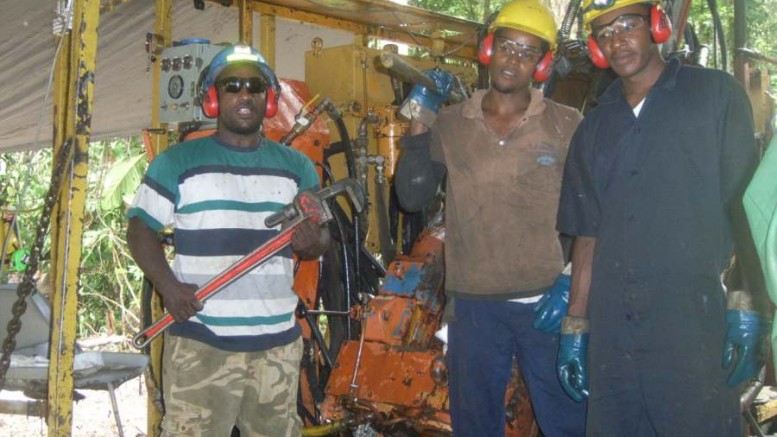When it comes to unearthing gold in a rough-and-tumble mining jurisdiction like Guyana, explorers are often faced with infrastructure-based speed bumps on the road to establishing an economic deposit.
But at least two explorers are making notable progress there: Toronto-based Guyana Goldfields (GUY-T) and Australian newcomer Azimuth Resources (AZH-T, AZH-A) have both unveiled multi-million-ounce gold resources, and are aiming at becoming players in a revived commercial gold-mining industry in the country.
Guyana Goldfields is at a more advanced stage, having received its large-scale commercial mining licence in November and filing an inaugural feasibility study in April. The company has faced its share of adversity over the past five months, as questions surround the economic viability of its Aurora gold deposit, 170 km west of the capital Georgetown.
Trouble started in mid-February when the company released a feasibility study showing a hefty estimated US$626-million capital expenditure and a relatively low 12.6% after-tax internal rate of return at a US$1,300-per-oz. gold price. Owing to Aurora’s distance from potential power supplies and shipping avenues, Guyana Goldfields was forced to contemplate high fuel costs and heavy infrastructure spending that would dampen the project’s profitability.
The company saw its share price plummet 67%, or $5.34 following the release of Aurora’s initial feasibility study on Feb. 12, though a recent resource update and news of a re-optimized economic strategy have driven share increases over the past several weeks.
Market sentiment began shifting in May, and benefited from added momentum when Guyana Goldfields announced a change in Aurora’s development strategy on June 13. According to reports, a bankable feasibility update scheduled for year-end will focus more on Aurora’s surface-mining potential — whereas the previous study had leaned on an underground component — as the company intends to drop a proposed vertical shaft operation in favour of a ramp decline that would hit 750-metre vertical depths. Oxidized ore would be mined and processed over an initial two-year period, followed by hard-rock, open-pit and underground mining operation.
An additional update portended an improvement in economics when Guyana Goldfields increased Aurora’s measured and indicated open-pit resources by 27% on June 25. The company boosted its open-pit measured and indicated resources by 580,000 oz. gold, to a total of 33 million tonnes grading 2.62 grams gold per tonne for 2.8 million contained oz. Higher-grade underground indicated resources were also on the rise, totalling 27 million oz. grading 3.9 grams gold for 3.8 million contained oz.
Guyana Goldfields has leapt 47%, or 83¢ over the past five weeks, en route to a $2.60 presstime close. The company completed a US$30-million non-brokered private placement in late April by issuing 10.9 million shares at $2.91 per share. It has 84 million shares outstanding with a $219-million market capitalization.
BMO Capital Markets analyst Andrew Kaip maintains a $5 price target on the stock with a “market perform” rating. He notes that the expanded resource came with a 27% drop in open-pit grade, from 3.34 grams gold to 2.62 grams gold. According to preliminary estimates, BMO Research is modelling a US$525-million mine development at Aurora that includes an 8,000-tonne-per-day open-pit operation, followed by a US$270-million underground expansion in 2017.
Meanwhile in Guyana’s historic Omai gold district to the south, Azimuth is defining another large-scale gold resource at its West Omai project, 60 km west of the old Omai gold mine. Since joining the Toronto Stock Exchange in May, Azimuth has established what it describes as a “shallow, non-refractory inferred resource” at West Omai, totalling 12.4 million tonnes grading 3.1 grams gold for 1.22 million contained oz. Included in Azimuth’s total is a higher-grade resource at its Smarts deposit that carries an intriguing 5 million tonnes at 4.6 grams gold for 750,000 oz.
The company says the deposits extend to a maximum depth of 200 metres, with 80% of the total ounces within 140 metres of surface. Azimuth has also completed preliminary test work that demonstrates 93% oxide and primary mineralization recoveries using cyanide leaching and gravity processes.
Azimuth benefits from two infrastructure advantages that could make project feasibility less daunting. The Guyanese government is planning to build a 165-megawatt hydroelectric plant nearby that could provide West Omai with a more affordable power supply. Next, Guyana’s only major roadway — which runs from Georgetown to the Brazilian border — passes relatively close to Azimuth’s potential open-pit mine. An access road is under construction, making transportation less of a cost burden.
Though Azimuth owns an 8,000-sq.-km land position in the Omai gold district, upstart Vancouver-based explorer Tajiri Resources (TAJ-V) holds a majority interest in a potentially strategic piece of the puzzle in the centre of the Australian explorer’s inferred resources. Brand new to the Guyanese gold space, Tajiri recently filed its inaugural technical report on its Kaburi PL property, which occupies 26 sq. km on the Guiana Shield greenstone belt. Kaburi PL also hosts a number of artisanal gold pits — the Omai district is a favourite of local miners — and Tajiri intends on undertaking a scout drilling program over the next few months.
Another explorer in the southern part of the country is Guyana Frontier Mining (GYG-V), which released results from a 2012 exploration program at its Marudi Mountain project on June 22. Though the explorer failed to hit similar grades to the Guyana Goldfields and Azimuth deposits, Guyana Frontier did intersect 3.4 grams gold over 4 metres and 1.9 grams gold over 8 metres in hole 12-140.
Both Tajiri and Guyana Frontier have bounced around in the 5¢ range over the past several weeks, with Tajiri holding a $1.2-million market capitalization at presstime with 24 million shares outstanding, and Guyana Frontier maintaining a $5.2-million market capitalization with 94 million shares issued.


Be the first to comment on "Guyana’s jungle holds rewards for gold explorers"